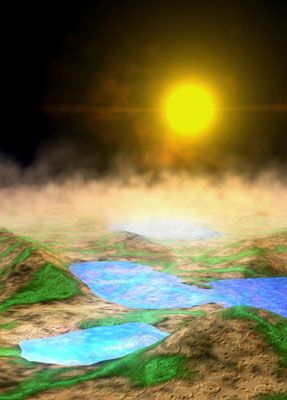Life might exist on such a planet. A space telescope called COROT (COnvection ROtation and planetary Transits) designed by the French Space Agency. It's a 30-centimeter-diameter space telescope that will look for slight changes in the brightnesses of nearby stars. It will be launched in 2005 from Russia

Life might exist on such a planet. A space telescope called COROT (COnvection ROtation and planetary Transits) designed by the French Space Agency. It's a 30-centimeter-diameter space telescope that will look for slight changes in the brightnesses of nearby stars. It will be launched in 2005 from Russia.
credits: ESA 2001. Illustration by Medialan
It is possible that in a tenth of the stars in our galaxy the conditions suitable for the existence of complex life can be found, say Australian researchers. Most of these stars are on average about a billion years older than the Sun and therefore allow much more time, theoretically, for any life to develop.
The idea of a "galactic habitable zone" (GHZ - Galactic Habitable Zone) in the Milky Way galaxy was first proposed in 2001. Now, Charles Leinweaver of the University of New South Wales and his colleagues have delineated a life-friendly GHZ using a detailed model of the evolution of the Milky Way galaxy. The model helped them to map the distribution in space and time of four central factors, which are considered essential for the development of complex life.
"We will pick up what we consider to be the strictest and most conservative prerequisites for life - but they are very, very basic," says Leinweaver.
The researchers concluded that a disk-shaped area suitable for life appeared about eight billion years ago, about 25,000 light-years from the center of the Milky Way. The region slowly expanded to include stars that were born up to four billion years ago. It encompasses close to ten percent of the stars that have ever been born in our galaxy.
However, other researchers claim that we do not know enough about the prerequisites for life for this mapping to have much meaning.
"We hardly understand the origin of life, let alone the evolution of complex life. Until we understand more, it will be difficult to talk about habitable zones," said Mario Livio of the Space Telescope Science Institute in Maryland, USA, to the journal Science.
Leinweaver emphasizes that his team claims that complex extraterrestrial life is highly likely, or even exists, in their GHZ. "We say that this is the area with the most potential for the formation of complex life," he says.
The first factor, which the team took into account in the mapping, was the presence of a sun, around which a solar system could develop. The second was the presence of sufficient heavy elements to form terrestrial planets. The third was a sufficient safety distance from exploding supernovae, and the fourth was enough time for biological evolution. The team determined the minimum for this number to be four billion years, which is the time it took for complex life to develop on Earth.
The importance of some of these factors will be tested later, the team added. Only about a hundred extrasolar planets have been discovered so far, and all of them are gas giants similar to Jupiter. However, the launch of NASA's Terrestrial Planet Finder Telescope (Terrestrial Planet Finder Telescope) in about 2013 will mark the beginning of the great search for nearby planets that may contain life.
3.1.2004
Alex Doron's version of the same topic:
Scientists have found an area in the galaxy suitable for settlement
Alex Doron
New research in the field of astronomy and astrobiology marked what was immediately dubbed "our suburban stars". An Australian-American team has identified the best area, in their opinion, in our Milky Way galaxy, right in the depths of space, where it is possible to settle.
These are two billion stars - about ten percent of all the bodies that make up our galaxy - which according to all signs contain all the chemical elements required for the existence of life and are also "adult and mature" enough to allow the flourishing of sophisticated civilizations. "It is possible that there are 'Bnivrit', small green human-like creatures, just like it is written in the science fiction books," stated one of the researchers.
This is another scientific effort aimed at locating extraterrestrial intelligence, or in other words, the existence of human-like intelligent beings in our galaxy. It is now estimated that ten percent of the Milky Way allows this. The distant rocky stars that have been located have atmospheres and water and have been labeled as capable of harboring life. They also have carbon, oxygen, iron, aluminum, silicon and uranium - that is, heavy chemical elements that allow the design of an Earth-like star.
This research has been going on for ten years and deals with scanning the depths of the sky and space, listening for any weak signal that comes, if any, from distant stars. Today the researchers have already reached enormous distances: 40 light years from us. Obviously, these are distances that are too great to sustain a journey to these stars, but the researchers believe that it is possible that there are intelligent beings at such distances. "Maybe they're even using something similar to our television," noted Dr. Charles Leinweaver from Australia's New South Wales University in an interview with the weekly "Science."
The team of astrobiologists (experts in astronomy who focus on the biology of the stars) noted that our "suburban region" in the galaxy is 250 thousand light years away from the galaxy's core. It was "born" eight billion years ago, while our sun and the stars in the solar system are relatively "newcomers" in the galaxy: they arrived (actually formed) four billion years ago.
